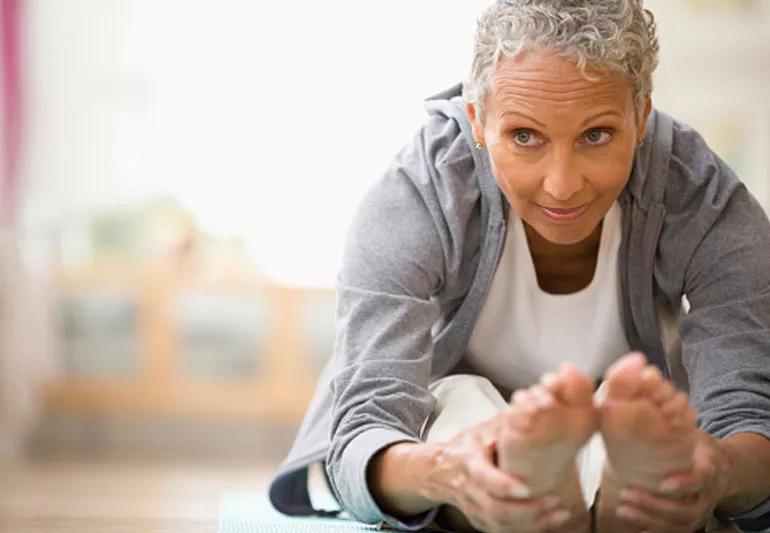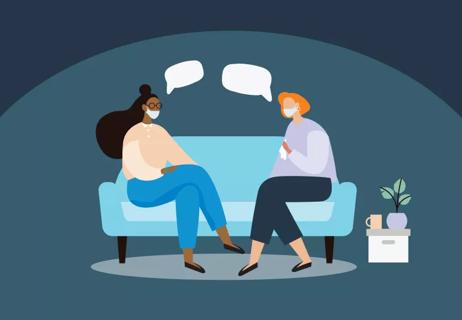Aerobic exercise paired with resistance training is good, but an individualized plan is best

It’s a given that exercise is one of the best things you can do for your health. After all, being physically active has lifelong benefits, including building muscle strength, boosting heart and brain health, and increasing energy.
Advertisement
Cleveland Clinic is a non-profit academic medical center. Advertising on our site helps support our mission. We do not endorse non-Cleveland Clinic products or services. Policy
If you’re living with the genetic condition Huntington’s disease, regular exercise is even more important. The condition often causes physical symptoms that progress (and worsen) over time, generally over a period of 15 to 20 years. As a result, physical activity not only provides overall health benefits, but also helps with daily living activities.
Physical therapist Christy Ross, PT, DPT, who specializes in working with geriatric patients, discusses the benefits of physical activity and specific exercises that help if you have Huntington’s disease.
Through genetic testing, you can discover you have the gene mutation that causes Huntington’s disease long before you experience any physical or mental changes. But, you aren’t officially diagnosed until after you develop symptoms.
Common early signs can include difficulties with your balance or mental focus, or the emergence of a mood disorder such as depression or anxiety.
The nerves in your brain start to deteriorate even before you have outward signs of Huntington’s disease. That’s why starting an exercise routine in advance is so important, Dr. Ross says.
“If you know you might be at risk for Huntington’s disease, you want to start exercising as soon as possible,” she says. “If you’ve already started developing symptoms, we may be able to actually maintain and maximize your functional abilities as much as possible.”
Advertisement
“Functional abilities” is a broad term encompassing things you do every day — such as getting in and out of bed, dressing yourself and bathing — as well as larger tasks such as doing the laundry, going grocery shopping, cooking and taking care of your finances. But in addition to helping you continue doing these daily activities, exercise can also help you keep doing things you enjoy, such as socializing with friends, hobbies and recreational activities.
“Many impairments from Huntington’s disease reduce your quality of life,” Dr. Ross says. “Because some of the cognitive and physical impairments develop early, you want to start doing appropriate therapies as soon as possible. Aerobic exercise paired with resistance training is going to be the best to help slow down the impairments caused by the disease.”
Physical activities can help lessen the physical symptoms of Huntington’s disease. In fact, at the moment, a combination of aerobic exercise and resistance training is considered your best option. Among other things, aerobic exercise can help boost your stamina, strength, balance and flexibility.
“There’s a phrase for aerobic exercise that I like — ‘Whatever is good for the heart is good for the brain,’” Dr. Ross says. “Aerobic exercise helps protect your brain and may slow the progression of nerve deterioration in Huntington’s disease.”
However, researchers haven’t yet found evidence that exercise can definitively delay the development of Huntington’s disease — or prevent it from developing at all.
“To date, there is no particular treatment that will actually prevent Huntington’s disease or definitely slow down the progression,” Dr. Ross says. “Researchers have found that aerobic intensity can help improve motor function and improve fitness. So, overall with those improved abilities, does that slow down the disease process? That will take larger studies to determine.”
The exercises that work best for Huntington’s disease depend on how the condition is affecting you physically. For example, some people with Huntington’s disease develop a condition called chorea, which makes your muscles move in involuntary or unexpected ways. Although chorea can be controlled by medication, you may need to find a form of exercise that won’t put you at risk for falls or other injuries.
In general, moderate-intensity aerobic exercise is the best option for building cardiovascular fitness and achieving brain-protection benefits. “There really isn’t one specific program or type of aerobic exercise that’s considered the best thing to do,” Dr. Ross says. “It’s whatever you’re safe doing and what you have access to doing more consistently.”
Advertisement
For example, swimming might be easier in the summer, when neighborhood public pools are open, but more difficult to do during the colder winter months. However, stationary biking is something you can do year-round at your house. “Getting your heart rate up is important,” Dr. Ross says. “That’s really helpful for improving fitness. And then you’re improving your fitness and you, also help improve your motor skills, which is helpful for building balance and decreasing chorea.”
Doing a form of exercise you enjoy is also important. “If you enjoy it, you’re going to stick with it,” Dr. Ross advises. “Everybody’s body is different to begin with, and what you have for support and resources also differs. And you might not enjoy doing one form of exercise because someone else did. It’s definitely individualized.” You might not be the biggest fan of running, but prefer organized group exercise class team sports like softball or soccer.
An exercise routine also doesn’t have to be overly complicated. A simple walking program, either done by yourself or with a walking partner, can be a good option. “Sometimes, people might need a caregiver to walk with them,” Dr. Ross says. “This isn’t necessarily for balance, physical support or safety, but to help out with accountability or positive affirmations and positive support.”
Advertisement
Your fitness needs will change as Huntington’s disease progresses. In the time between nerve degeneration and when you start developing visible symptoms, you might work on preventive exercises geared toward maintaining life skills or delaying the onset of physical symptoms.
If you’re starting to experience symptoms, using a modified stationary bike might be a good fit. “Sometimes, people will do a passive assist bike,” Dr. Ross says. “If you’re having a hard time coordinating your movements, there are different bikes that have a motor on it that can help you out.” You might also need to use an assistive device (such as a cane or walker) in your walking program.
As the disease gets further along, exercises are geared toward helping you navigate your home and public places. This includes maintaining your balance and improving your posture so you can still swallow safely.
Before beginning any exercise routines, either at home on your own or under the guidance of a care team, you’ll want to have sessions with a physical therapist. “We can test you to see if you’re at risk for falls,” Dr. Ross explains. “Depending on what we’re identifying, then we would give you the most optimal type of exercise you can do within your available space and support. We can also help you identify what physical activities you might enjoy the most.”
Advertisement
Huntington’s disease symptoms frequently include muscle weakness, balance issues and two conditions that cause involuntary muscle movements, dystonia and chorea. As a result, your exercises might address how to walk safely in your house or outside in public places, or help improve your endurance.
“I like to relate the exercises to something you’re having trouble with functionally,” Dr. Ross says. “So if you”re having trouble with walking, you might stand in place, in a walking stance, and add in more movements — looking up, looking down, sideways head turns. When you’re walking, you might turn your head to greet other people or look at different things around you, while navigating a variety of ground surfaces and potential obstacles.”
Physical therapists might also work with you to keep your mental functions sharp. In particular, this can be related to remembering the proper order for doing tasks, like standing up with your walker or approaching a chair. “You might have some executive functioning trouble, some deficits, because of the Huntington’s disease,” Dr. Ross says. “It affects all parts of the brain, including short-term memory and planning and attention to safety.”
One solution to this symptom, she adds, can be breaking tasks down into step-by-step order, or reinforcing how to do something in a positive way. “We call it errorless learning,” Dr. Ross says. “It’s trial and error without error. It’s not saying ‘No, you did that wrong’ or ‘No, you should have done this,’ but instead, using positive guidance to help you successfully complete a task.” Occupational therapists might also work with people on similar tasks such as dressing, putting toothpaste on the toothbrush, and meal planning or preparation.
Your caregivers might also get help from physical therapists to stay safe as they help you. “If someone is in a wheelchair, we’ll do positional training so you don’t develop any pressure injuries,” Dr. Ross says. “We do a lot of stretching and care-partner training for both the upper and lower body.” This is to prevent you from developing contracture, or your muscles shortening due to dystonia or the chorea. “We don’t want you to be limited in your range of motion, which could then cause difficulty getting dressed, or going to the bathroom or with getting in or out of bed,” Dr. Ross says. “A daily stretching program with a caregiver is really helpful.”
In general, the Centers for Disease Control and Prevention (CDC) recommends people who are healthy incorporate exercises in the areas of aerobic exercise, flexibility, balance and strengthening. “These are recommended for healthy aging — for kids, teenagers, adults and aging adults,” Dr. Ross says. For people living with Huntington’s disease, these exercises can be wrapped in with some specific fitness regimens and types that are based on your individual needs.
In earlier stages of Huntington’s disease, range of motion exercises could be something like tai chi, yoga or Pilates classes. If in-person sessions are difficult, Dr. Ross says online classes are a good option. For help finding these kinds of programs and others, the Huntington’s Disease Society of America, the European Huntington’s Disease Network or the ENGAGE-HD Physical Activity Workbook are great resources, she adds.
Tai chi and yoga can also help with balance. However, Dr. Ross says you don’t need a formal class or program to work on building balance. Find a hallway and a place to support yourself and try walking on your toes or heels, sidestepping or walking backwards. While at home, even simply standing in place is a great way to improve your balance — whether you’re balancing on two feet, or doing more challenging moves, such as heel or toe raises, or practicing standing on one foot.
If you’re using a wheelchair, basic standing basic exercises might need some modifications, Dr. Ross says. “Maybe you can practice doing things with one hand if you’re standing at the countertop when someone is helping you get dressed, or after you’re brushing your teeth.” And if falling is a concern, you can also strengthen your balance while seated.
“Can you sit on the edge of the bed and keep your posture upright?” Dr. Ross asks. “Can you do this if you are nudged on the shoulder? Are you able to successfully put your arm down and then push yourself back up and regain your balance? Chorea can sometimes cause you to lean to one side, but by using your core muscles, can you keep your balance and stay upright?”
Strengthening your core — the muscles in the middle section of your body, encompassing your torso — is also important. A stronger core leads to better posture and positioning, which improves your stability when walking, standing and sitting. It also supports vital activities such as breathing and eating, Dr. Ross says.
If you have Huntington’s disease, a stronger core is also important to help you control the involuntary movements you might have due to chorea. “We try to really focus on the core training, the abdominal muscles and the extensor muscles, but then also our lateral support, lateral trunk and our hips, to our pelvic muscles,” Dr. Ross says. “This ties into posture and breathing exercises, and can help out immensely with swallowing abilities. Strengthening your leg, back and abdominal muscles may also help you have more control and maintain your balance when you have chorea movements.”
One exercise can involve being on your hands and knees and then lifting one arm or leg. Another strengthening exercise option is doing what Dr. Ross calls sit-to-stand. After standing up, you lower yourself slowly back down into a sitting position. “The slower you move, the more muscle control that is required,” she says. “Doing these might help you gain stability.”
In the middle to later stages of Huntington’s disease, your ability to breathe and swallow will be affected. Building up aerobic endurance in advance will help you manage this progression better. “When you think about breathing, we need to have as much flexibility and chest expansion, and best posture as possible,” Dr. Ross says.
Due to the effects of Huntington’s disease, you might also have trouble coordinating your breathing and sound like you’re short of breath. “That can also occur in conjunction with some of the anxiety and other behavioral concerns you might have,” Dr. Ross explains.
Practicing breathing techniques is one common solution. “Our music therapists use relaxation and music to help out with breathing and coordinating that movement to help them take a better breath, or to support their voice with speech,” she adds.
In later stages of Huntington’s disease, the coordination of swallowing also becomes more of a challenge, Dr. Ross says. “And if you’re aspirating (choking), you might develop more respiratory problems from that.” In this case, a speech-language pathologist is a big help. They can help you improve your vocal capacity and swallowing abilities, and the coordination of your throat muscles. In addition, speech-language pathologists can work with you on eating and drinking safely. They work with you on proper positioning and potentially even recommend modification to food textures, too.
If you have Huntington’s disease, you’ll likely work with a physical therapist to develop a home exercise program. “We can assess you, see where you’re a and help with training so that you’re operating at the best level possible,” Dr. Ross says. “We can give you a home exercise program you feel confident in doing that you can try on your own for a little while.”
Putting together this program involves not just identifying goals, but troubleshooting any barriers you might have. For example, you might not know where to begin with exercising, or might need a push to actually do your routine. “Many times, people just need a visual daily schedule to say, ‘OK, I’m going to set 10 minutes aside to actually do it,’” Dr. Ross says. “Or you might need a support partner or an accountability partner. And then it’s also important picking something you enjoy.”
Part of this routine also involves being flexible and kind to yourself. Dr. Ross notes that chorea can cause your energy to fluctuate because you’re moving so much, or you might have more energy at certain times of the day. “Find exercise you can do within your energy level,” she says. “If you don’t have a lot of energy, maybe you could try something like yoga or tai chi. If you have more energy, and you’re feeling good, maybe you’ll do something like strengthening or aerobic exercise. Yoga and tai chi go hand-in-hand with mindfulness and relaxation techniques.”
Chorea can also affect your coordination or ability to swallow, so you also need to be careful you’re getting enough calories and staying hydrated. Dr. Ross says a nutritionist and a speech therapist can offer help.
Continuing to see a physical therapist on a regular basis is a good idea. Not only can therapists make sure your home workout plan is still helping, but follow-up sessions can also help you maintain your functional abilities. “We recommend for you to come every year, at a minimum,” Dr. Ross says. “Many times, you might be more on a maintenance program, so we’re seeing you throughout the year, one-on-one for periods of time. We might see you anywhere between six and 12 times, or maybe even a little bit more just depending on what your needs are.”
But above all, regular exercise can also give you a mental health boost. “If you’re experiencing some anxiety, there are some benefits to exercise, depending on what your energy level is, how much time you have, and what your life includes,” Dr. Ross says. “It all goes back to an individualized physical therapy treatment plan and home exercise program.”
Learn more about our editorial process.
Advertisement

Here’s what to know about employment when living with this condition

Share your diagnosis with an inner circle of family and friends you can rely on

Ways to take care of your mental and physical health

An expert outlines everything you need to know

The neurological disease can make it hard for individuals to take care of themselves

Physical activity can help preserve and improve your cognitive function and fend off dementia, stroke and other health concerns

Lower-intensity workouts can deliver high-quality health and fitness results

Incremental changes in your exercise routine can improve your strength and endurance over time

The ‘sunshine vitamin’ is found naturally in some fish and is added to other foods

Autism and ADHD often go hand in hand, giving rise to the term AuDHD

The Yuzpe regimen is less effective than other forms of emergency contraceptives, and it’s associated with more side effects